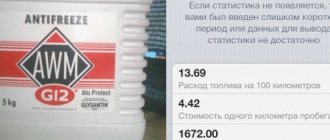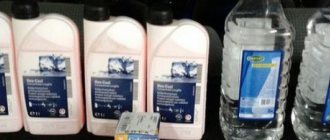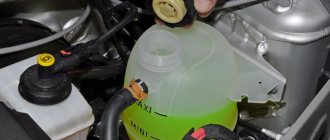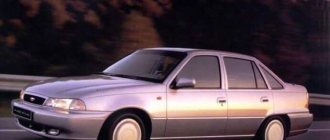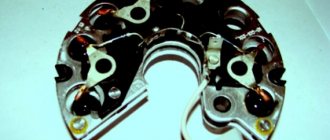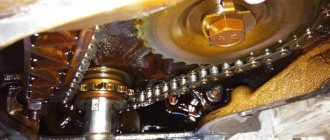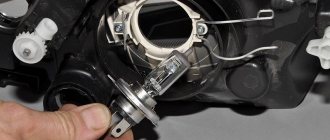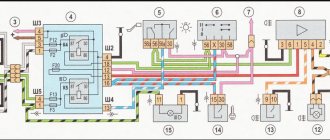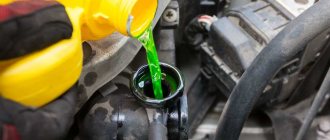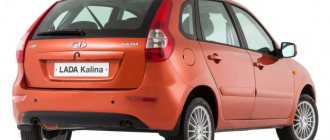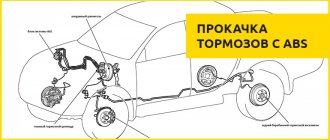01/25/2022 8 149 Coolant
Author: Victor
Antifreeze is one of the main consumables in any car. The refrigerant is designed to cool the power unit, which helps prevent it from overheating. How to replace Lanos antifreeze, what fluid to fill and how to check its level - you will find here.
[Hide]
What type of coolant is used?
Replacing antifreeze in a Daewoo or Chevrolet Lanos is an important step in vehicle maintenance. Normal operation of the cooling system is impossible when using low-quality or expired antifreeze. First, let's look at what refrigerant is used and what refrigerant needs to be filled in the Chevrolet Lanos.
Expansion tank with “Antifreeze” in Lanos
To know what kind of antifreeze is poured into the system, you need to remember the brand of liquid that you poured. Initially, the plant uses ethylene glycol-based refrigerant during production. Information about this is indicated in the service book for the operation of the vehicle. If you filled in another Antifreeze, you should know which one it is.
What coolant is best to fill?
Replacing antifreeze in Lanos must be carried out taking into account the requirements of the automobile manufacturer. Therefore, in the cooling systems of these cars, only consumables made on the basis of ethylene glycol should be used. We won’t talk about specific brands of liquid that can be used - there are plenty of them. When purchasing a refrigerant, be sure to read its composition; it is indicated on the label on the back of the package.
The use of plain water is also not allowed. If you had to add water, for example, when all the coolant for some reason boiled away and the engine overheated, then as soon as possible it needs to be replaced with a full-fledged coolant. Especially if this happened in winter. At subzero temperatures, water freezes, which can lead to damage to the components of the cooling system.
How often should antifreeze be changed?
According to technical regulations, antifreeze in Chevrolet Lanos cars is replaced at least every 40 thousand kilometers. Or once every four years. During this time, the liquid will lose its properties and will not be able to perform the tasks assigned to it.
Used and new antifreeze for Lanos
How to determine that replacement is required?
Changing and filling the coolant is carried out in the following cases:
- If there is sediment at the bottom of the expansion tank. Looking at the tank, you will see how there is a dense layer of sediment at the bottom. Or all the liquid in the expansion tank may be in the form of a large lump. Often deposits form at sub-zero temperatures. Sediment may appear in the radiator and in the cooling system pipes. But it is visible only in the expansion tank. If there is sediment in the cooling system, replacing consumables is accompanied by a complete flushing of the radiator, tank and lines.
- If the freezing point of antifreeze has increased. To check, you can use a special device - a hydrometer. You can find the device in any automobile store. If the properties of the coolant have changed, the consumable must be replaced. Antifreeze density is checked in accordance with the technical table, which can be found in the service manual for the car. If you don't have a hydrometer, you can do without it. When the ambient temperature drops to -15 degrees, carefully unscrew the cap on the expansion tank. If there is a yellowish coating on the surface of the liquid, then the consumable material has begun to thicken. In the future, this will lead to its rapid freezing. Then the refrigerant must be replaced.
- The main symptom is that the consumable material loses its natural color. It becomes brown, with a hint of rust. In this case, the refrigerant reacts with the metal components of the radiator device and can lead to their destruction. As a result, the radiator will fail. When the refrigerant becomes discolored, it cannot perform its intended functions. Because of this, the engine overheats. Then the refrigerant needs to be changed.
- The liquid turned into a cotton-like state. This can be seen in the summer heat. The appearance of flakes in the liquid indicates the need to replace it.
- Formation of foam on the surface of the antifreeze in the expansion tank. When the refrigerant foams, it means it needs to be replaced. If you ignore the appearance of foam, the power unit will overheat.
- Indirect signs include inefficient operation of the stove. As a result of the fact that the coolant cannot perform primary functions, the heater operates less efficiently. This is especially felt in the winter season.
The brown color of antifreeze indicates its ineffectiveness.
Replacing antifreeze in Daewoo Lanos
Coolant (coolant) must be replaced every 40,000 (km) mileage, just like other Lanos spare parts must be changed according to regulations.
If this is not done, then the antifreeze completely loses its properties. This moment entails the formation of corrosion in the cooling circuit, engine overheating and many other consequences.
The following signs indicate the need to replace antifreeze on Daewoo Lanos:
- The radiator forced cooling fan started to turn on frequently
- The density of antifreeze has decreased significantly (density is measured with a hydrometer)
- The coolant has changed color (to a shade of rust)
It is worth noting that all coolants have pronounced carcinogenic properties. Ethylene glycol-based liquid is especially toxic.
Its closest analogue is propylene glycol, it is less harmful to the human body , but costs much more than ethylene glycol.
It should be separately noted that when replacing the coolant, it is strictly forbidden to simply pour the “working off” onto open ground .
Old antifreeze is disposed of by flushing it into the centralized sewerage system (does not apply to service stations, only to private craftsmen).
How to check the antifreeze level?
Checking the fluid level is carried out according to the marks on the expansion tank:
- Open the hood of the car, find the expansion tank, it is located on the right when you stand facing the car.
- Take a close look at the container. There are two marks on it - MIN and MAX. Ideally, the fluid level should be between these two marks. If the level is lower, coolant must be added. Checking the antifreeze level is performed on a cold engine.
Coolant volume
Before replacing, you need to know how much fluid to pour into the cooling system. In the case of Lanos, the volume of consumables used is 7 liters; this information is indicated in the operating instructions for the car. As practice and reviews from Lanos car owners show, replacing consumables requires no more than five liters. This is due to the fact that due to the design features of the car, you will not be able to completely drain all the “Antifreeze” from it. There will definitely be some liquid left in the system, there is no way around it. Even if you comply with all the requirements and rules for draining consumables from the unit. In addition to antifreeze, you need to purchase about seven liters of water if you plan to flush the cooling system. And if there is sediment in it, flushing is mandatory.
You can learn about the consequences of using low-quality antifreeze from the video below (the video was filmed and published by the Jeep Bomb channel).
How to choose and replace antifreeze on a Chevrolet Lanos: step-by-step instructions
Replacing coolant on a Chevrolet Lanos
And you need to decide on the brand in order to buy high-quality coolant. If, after a certain period of time, the antifreeze you poured in loses color, for example, a fairly common case turns brown, then you can be congratulated on purchasing a fake antifreeze. I loosened the clamp, removed the pipe from the pump, and it drained.
Millions of car owners choose SINTEC quality.
But for this you will have to acquire a special hydrometer. Next we will flush the cooling system. It turns out that everything is like in a pharmacy:
It is written that the bottle is designed for liters. From personal experience, drivers have verified that it only costs 5 liters to buy a fluid change in Lanos. In the next article we will tell you how to change antifreeze on a Mitsubishi.
Sometimes there are problems with coolant leaks in the car model in question. The antifreeze level is below the permissible level. Air lock when filling.
Loose hose fastenings. However, there may be completely different problems. After putting everything back together, before putting it on, you can lightly coat the inside of the hoses with lithol.
Where does the antifreeze go? Daewoo Lanos 1.5 cylinder head repair.
I filled it with water, warmed it up, and just drained the yellowish cloudy stuff from the radiator. I filled it with water again along with this thing: It says that the bottle is designed for liters.
I poured out half the bottle. I warmed it up, drove it for 30 minutes, and again drained everything I could after removing the hoses.
I filled it with water again, warmed it up, and drained it. Based on the operating instructions for a Chevrolet Lanos car, you should fill it with a liquid based on ethylene glycol.
It is recommended to listen to the manufacturer’s recommendations and not to add other liquids, including water, into the system. When to change Already at 40 km, the antifreeze will look like this.
But another important point is when to change the fluid in the system. I’ll explain why exactly five liters.
Due to the design features of the Daewoo Lanos car engine, which does not have a drain plug on the block, it will not be possible to completely drain the antifreeze!
With all the tricks discussed below, coolant remains in the engine block. So, there is no point in taking the full amount of antifreeze.
I will not recommend a brand of antifreeze, since the choice in markets and stores is very large and no one will insure you against buying a counterfeit with a sticker of the recommended brand. If you have acquaintances or friends at a car market or auto shop, you can consult with them. If not, please show quality certificates of the goods being sold.
How to change the coolant?
Let's take a closer look at how to replace antifreeze in Lanos with your own hands.
Required Tools
To replace you will need the following tools:
- pliers;
- screwdriver;
- 10mm wrench, it is better to use a socket wrench;
- a bucket or old basin into which the waste liquid will be drained (a cut-off five-liter bottle will do);
- a jack to raise the front of the car;
- a watering can or funnel, with its help you will carefully pour in the new “Antifreeze” (the cut off top of the bottle will also work).
How to drain?
Changing a consumable begins with draining it:
- It will not be possible to completely remove all the antifreeze from the system, but you should try to drain as much fluid as possible from the engine. To do this, the vehicle must be placed on a flat surface; it will be more convenient to drive it into a pit or overpass.
- Find the refrigerant drain plug on the radiator; it is located on the left, in the lower corner, as shown in the photo. Place a prepared container under the plug to collect used antifreeze. Unscrew the lid.
- After this, unscrew the filler cap located on the expansion tank.
- The draining process will begin. To quickly drain consumables from the system, you need to remove the pipe from the fitting located on the throttle. This pipe is removed from the throttle assembly using pliers or a screwdriver.
- You won’t be able to drain all the refrigerant, but you can try to minimize the remainder in the cooling system of the power unit. To do this, take a jack and use it to lift the rear right wheel.
1. Plug for draining antifreeze in the Lanosov radiator
2. Remove the pipe from the fitting for faster draining
3. Clean the expansion tank and flush the cooling system
4. Fill the reservoir with new refrigerant
Flushing
If the antifreeze has never been changed before or there are deposits in it, then the system must be flushed.
Otherwise, the dirt that remains in it will not allow the liquid to fully perform its functions. Water is used to flush the cooling system. Buy distilled water; tap water is not recommended. It contains substances and microorganisms that can lead to corrosion on metal elements of the system, for example, a radiator.
- Flushing is performed by tightening the plug on the radiator device with cream. About five liters of distillate are poured into the expansion tank. Water flows until it begins to flow out of the previously disconnected throttle pipe. When this happens, the pipe is put in place and the plug on the expansion tank is tightened.
- Now the car engine starts, it should run for 3-5 minutes.
- After this time, the water is drained from the cooling system. Assess the color and condition of the drained liquid - it will contain sediments and deposits, the color is usually brown. If the drained water is dirty, the washing process is repeated two to three more times. Flushing is done until the water drained from the system is as clean as possible.
- In practice, deposits also form in the cistern. Remove it using a 10mm wrench and rinse the container with clean water.
How to fill coolant correctly?
When draining and flushing are completed, new refrigerant is added. The drain plug is screwed in, the pipe from the throttle is installed in place. When pouring liquid, antifreeze must be added to the maximum mark on the tank body. To speed up this procedure, when filling, you should press the hoses of the radiator device with your hands from time to time. This will avoid the occurrence of air locks in the system. When the filling is completed, the power unit is started for a few minutes, then switched off. This is done to diagnose the refrigerant level in the expansion tank - it should decrease. If this happens, then the liquid is again added almost to the MAX mark.
Below is a detailed video instruction on how to independently replace the refrigerant in Lanos from the Garage TV channel.
Daewoo Lanos 1.6 16V SX FSO › Logbook › Replacing antifreeze
Hi all!
Since the mileage is approaching 80 thousand km, it is time to replace the antifreeze. As you know, on our cars replacement is carried out every 40 thousand km or every 4 years, whichever comes first.
As always, I will provide visual instructions on what and how to do. The operation is not complicated, but time-consuming, it can take about 2-3 hours, if you do the washing, like I did. I would advise replacing antifreeze with flushing the cooling system.
Here's my replacement kit
:
-HEPU® P999-G12-005 - 5 liters of concentrate - 470 UAH; -Distilled water - 20 liters - 65 UAH.
I’ll say right away that you can safely take 30 liters of water.
The operation of replacing antifreeze is best carried out in a pit; I did it at a friend’s place on a lift, which is also convenient :)
We drain the old antifreeze on a cold engine. To do this, we are looking for a drain hole. As the car moves, it is located at the bottom left of the radiator, on the 1.6 engine. At 1.5 it’s possible on the other hand, I don’t know.
Prepare a container with a volume of at least 5-6 liters in advance. We unscrew the drain plug, then unscrew the plug of the expansion barrel, the old antifreeze is drained into the container that we placed underneath.
It’s good that the system was not rusty and the antifreeze was not cloudy. Antifreeze G11 was filled in.
When drained, the antifreeze spreads like this:
Thus, I lost no more than 4 liters. Go ahead. Remove the pipe from the throttle heating:
More liquid will drain out. You can also blow into the pipe that we removed from the throttle and blow into the expansion tank. This will drain approximately 5 liters. Some people jack up the rear right wheel. I didn't do this.
After everything has drained, we tighten the drain hole, do not attach the pipe to the throttle, but fill it with distilled water until water flows from the hoses, then install the pipe on the throttle and add water to the MAX level. To better fill the system without air locks, you need to periodically squeeze the radiator hoses by hand. This way the system will be minimally aired.
After this, without tightening the expansion tank cap, start the car for a couple of minutes, watch the water level, and also press the radiator pipes by hand.
After a couple of minutes, turn off the engine and repeat the procedure: -unscrew the drain plug and drain; -remove the pipe from the throttle; - blow with your mouth into the pipe and tank; -tighten the drain hole; -refill water until it flows from the throttle pipe; -attach the pipe to the throttle; -add to the MAX level;
After the first drain of the water, it came out almost the same color as the antifreeze. With each subsequent flush it became cleaner and cleaner. I did 4 such flushes of the system; more could have been done, but then there would not have been enough water to dilute the concentrate. Therefore, you can safely take 30 liters of water if you have a clean system. And if you have a contaminated system, then much more. I think after about 6 flushes, I would have drained clean water. During the last flush, I warmed up the engine until the fan turned on. After 4 washes we see water like this, green dye is still present, but it’s barely noticeable:
Although my expansion tank was not dirty, I still decided to wash it for my peace of mind. To do this, unscrew the 2 nuts securing the tank.
We also remove all the pipes:
We rinse the tank with clean water and install it and the pipes in place in the reverse order.
Based on the fact that Lanos has 7 liters of coolant in the system, and we drained about 5 liters, we believe that about 2 liters of water remain there (because we thoroughly washed the system with water several times), it is necessary to fill in 3.5 liters of concentrate
in a 1:1 ratio with water.
That is, pour 3.5 liters of concentrate and add about 1.5 liters of water. 2 liters + 3.5 liters + 1.5 liters = 7 liters.
And we get
antifreeze with a pour point of up to -37°C
.
When filling with concentrate, we also fill until it starts to flow from the throttle pipe, then we put it in place and top up, while squeezing the radiator pipes with our hands to better fill the system.
We start the car, leaving the tank cap open so that the air comes out and does not create excess pressure in the tank. With the engine running, we also press the radiator pipes by hand.
We warm up the engine before turning on the fan; after turning on the fan, you can turn on the stove and run it in different modes. We turn off the engine. If the level of antifreeze in the system has dropped, add it to the MAX level, but add water, since we have already filled in the required 3.5 liters of concentrate. We tighten the cap of the expansion tank.
At this point, the replacement of antifreeze can be considered complete.
After a few days of using the car, you should monitor the antifreeze level and, if necessary, add water. And also monitor whether the antifreeze changes its color to brown or becomes discolored. If this suddenly happens, it means that you bought a fake and it is better to replace this “liquid” immediately.
Of the 5 liters of antifreeze I purchased, I have exactly 1.5 left. This means that they can be diluted 1:1 with distilled water and there will be another 3 liters for refilling.
This antifreeze is designed for 250 thousand km or 5 years of operation. Let's see how it goes. But the stove heats perfectly, which is good news.
Ready for winter! :)
Comments are welcome! I tried to describe it for you :)
Why might antifreeze leak?
Briefly about the reasons why a coolant leak may occur:
- Leakage can be confused with a decrease in the volume of consumables; this always happens in winter. During the cold season at sub-zero temperatures, the refrigerant in the expansion tank loses a little volume.
- The appearance of cracks and other damage on the tank. Detecting these defects, especially if they are minor, is not so easy. Sometimes they are not visible and look like scratches. Minor damage can be repaired by cold welding. If the cracks are serious, then the expansion tank must be replaced.
- The connections of the cooling system pipes have become depressurized. This is often due to loose clamps. These elements need to be tightened or replaced.
- Damage to hoses and pipes. They wear out as a result of long-term use or mixing of different types of antifreeze. The simultaneous use of coolants of different compositions can lead to a chemical reaction that has an aggressive effect on the rubber elements of the system - pipes and hoses. Damaged lines must be replaced.
- The thermostat gasket is worn out. Usually, when the gasket wears out, the thermostat itself changes, since the service life of these elements is the same. It is advisable to change the thermostat.
- Malfunctions in the operation of the radiator device. If the radiator is leaking, you can try to repair it using cold or argon welding. But this rarely helps; usually the radiators are simply changed.
- The leak may be due to antifreeze getting into the engine oil. This problem is the most serious and occurs as a result of damage to the cylinder head gasket or the cylinder head itself. You will have to remove the head and carry out detailed diagnostics of the unit. A damaged gasket must be replaced.
What are the signs to identify a leak?
- while driving, smoke came out from under the hood of the Lanos;
- after starting the engine, white steam comes out of the car's exhaust pipe;
- the stove does not work well, does not heat, but only cools;
- an engine fault indicator appeared on the dashboard;
- the temperature sensor needle has risen to the maximum;
- the car interior smells of antifreeze due to a leak in the heater radiator;
- a puddle appeared under the front seat mat.
Video “Visual instructions for flushing the cooling system”
Find out how to properly flush the cooling system in a Chevrolet Lanos and what needs to be taken into account from the visual instructions in the video (the material was filmed and published by Evgeniy Trushanin).
Do you have any questions? Specialists and readers of the AUTODVIG website will help you ask a question
Was this article helpful?
Thank you for your opinion!
The article was useful. Please share the information with your friends.
Yes (100.00%)
No
X
Please write what is wrong and leave recommendations on the article
Cancel reply
Rate this article: ( 6 votes, average: 5.00 out of 5)
Discuss the article:
